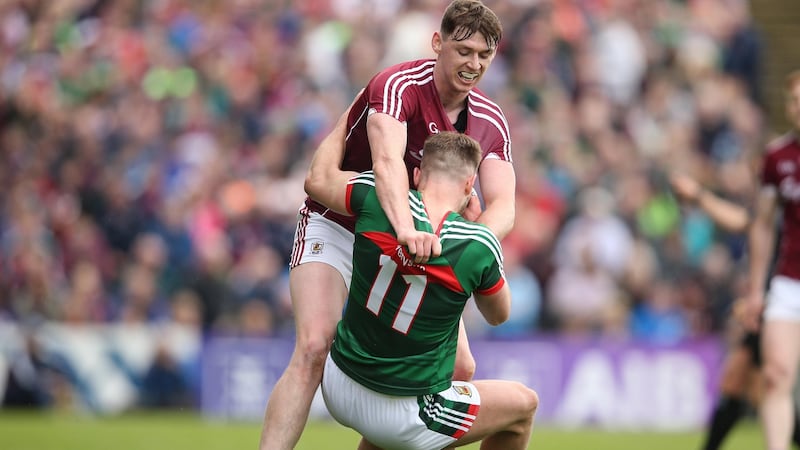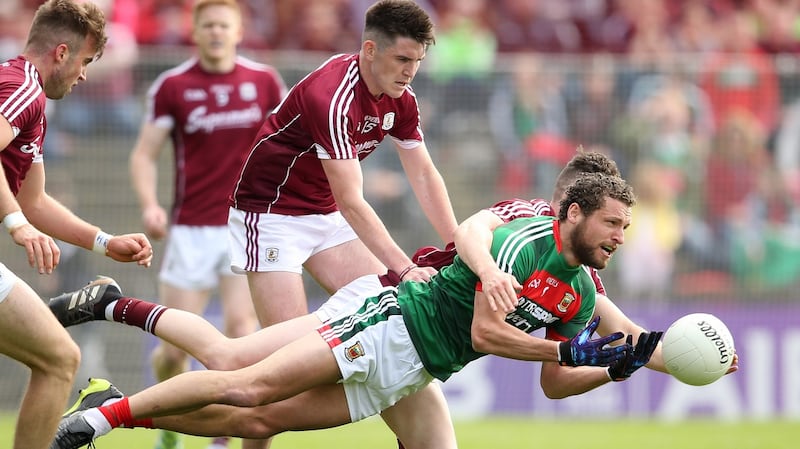The All-Ireland football championship is a huge, slow moving carnival but inside, things can change very fast. The result in Castlebar on Sunday leaves the big picture looking very interesting now. I watched the game in Glasgow and you could sense that this was one of those huge derby days that go beyond the mere winning of the game. The crowd was enormous and you could feel the anticipation and because of it, the game itself was obliged to deliver something special. But very soon after the throw-in, it became clear that Mayo were going to struggle to break down Galway’s defence. Then, there was an ironic twist in that once Diarmuid O’Connor was sent off and Mayo changed shape, Galway couldn’t break them down either.
So what went wrong for Mayo? When you look at some of their early missed shots - Aidan O’Shea, Paddy Durcan, Colm Boyle - were they as a consequence of an off-day or was it because of how Galway had set up? For me, it was because Galway forced Mayo to kick from outside the scoring zone, under pressure and against the wind. The big distinction between the teams was that Mayo had to work so hard just to get a shot away. They weren’t doing themselves any favours either in that they were very slow and methodical. The contrast between that and Sean Armstrong’s point for Galway’s first score, which came from a catch and pass from Ciarán Duggan and straight over the bar. That is what Galway are trying to do: control terms in their half of the field and then break with intent when they do win the ball.
I also felt that Galway didn’t just drop off all the time to merely ‘be defensive.’ They looked to press high early on in the game and Mayo were able to navigate a path through that cover. There was an instance when Diarmuid O’Connor had a scoring chance that was a result of Galway staying high but lacking the intensity to prevent the incision. There were other times when they used the mid-press, as I call it: a lot of bodies in the middle third trying to force a turn over. So from a Galway perspective, it wasn’t just a matter of sitting back in the last third. They tried, at times, to take the game to Mayo.
Our objective was to get the ball to someone close to the opposite sideline so Monaghan would squeeze towards that man and then we'd try to move the ball quickly back again
It made me think of Burnley in the Premier League and how high up the table they finished. They aren’t doing anything fantastic over and above what other teams did all season. But what they do really, really well is that they react at that critical moment when possession is lost. Now, you have to be brave and stand up and tackle and be disciplined and Burnley have made great strides there. But the most important thing is when they lose the ball, they revert to their defensive shape instantly. Most teams will carry two or three players who are a bit lazy or sluggish in that regard and get punished for it. Not Burnley. In a matter of seconds, they are back in situ. I think Galway have that quality too. As soon as Mayo played the ball inside, you could see the bodies very quickly getting back into the danger area.
Needless
However, I don’t believe Galway are the finished article defensively. They foul needlessly. All three fullbacks were booked. Some of the fouls - the Mayo forward with his back to goal and the defender pushing him in the back or going in over the top - were just needless concessions of scores. They are not as slick as they should be at this stage. And they cough up a lot of frees. A lot of the time, there is no need for the foul to take place. What I used to say to the Donegal boys is when you get to the moment where the tackle is about to happen, that is where you have to become three times more disciplined. You have to focus on winning the ball and I think that makes a huge difference in the eyes of the referee. I also feel their defensive intensity isn’t always there to the level it needs to be.
Now, they did a job: they forced Mayo to play a different game, keeping the ball outside the 45 and trying to draw Galway out but, for me, to no avail.

And the pattern of the match got me thinking about the strategies required of breaking down a packed defence. The first is the switch in play; getting the ball to the weak side and then exploiting the space or lack of cover. It was something Mickey Harte looked to do against Donegal in my time there. You’d see someone like Philip Jordan hugging the sideline waiting for the ball, anticipating the switch in play so he could attack the space.
We ourselves had a tactic against Monaghan in the 2014 Ulster final called the double switch - you go left with the ball to attract the defensive pressure to that side of the field, then switch right and drag the defence over with you and then move it sharply back again to the left of the field. Our objective was to get the ball to someone close to the opposite sideline so Monaghan would squeeze towards that man and then we’d try to move the ball quickly back again. It’s a way to create space in a tightly compressed defence.
Pods
The other important element is the dink-ball, as I call it, with the third man runner off it; that kicked pass inside bouncing in front of the receiving player is hugely important. It was a massive strategy for Jack O’Connor’s All-Ireland winning Kerry teams and I feel it has become a central element of Dublin’s game. And this is important. Dublin don’t just want players supporting the ball in an ad-hoc way. In my opinion, it is a requirement of management that three players be involved in every attack. In other words, nothing happens in isolation.
If you have players committed to running straight lines and getting ahead of the ball very aggressively, with options left and right, then you create multiple decisions and choices for a defence
In coaching speak, they play in pods. Dublin play in pods of three; the kicker, the man who wins the ball and, crucially, the third man runner. If you go back to Sunday’s game in Castlebar, that is where the Galway goal came from. If you go Ballybofey, that is where the Cavan goal came from. Why is it so important as a tactic? For me, it is because it plays on human nature. We are naturally programmed to anticipate danger. All eyes are drawn to the man kicking the ball and the man catching it. These are the primary threats. The reality is that nobody thinks about the third man runner. If we are being honest - hands on heart - certainly from my point of view watching the game and, I imagine, everyone in the ground, who among us saw Johnny Heaney’s first steps and said: oh, there’s a goal on here. People watch the players on the ball and then this strike runner comes from nowhere. By the time you identify that he is the threat, it is too late. And I think this is a primary reason Dublin have been so successful.
And trust me: it is very hard to cancel out. Even if you know that the player you are marking is a strike runner, it is very hard. In Donegal we put a huge emphasis on ‘anticipate the anticipator.’ But from four years of age, players are thought to focus on the man on the ball. Your attention is drawn to what you perceive as being the threat and is about to hurt you. The third man runner - the real danger - can be 15 metres away, about to take off. For me, it is the most difficult attack to defend against in Gaelic football.
Offside rule
The other thing that few teams really exploit to its full potential is getting ahead of the ball. This baffles me. Go back to soccer: the most difficult rule to navigate is the offside rule. All defences are basically shaped by this rule, right around the world. I watch championship games now and you would almost think there is an offside rule in place. Look at Castlebar: the ball was kept and moved, over and back. What is stopping players from sprinting into those pockets of space behind the defence? Then, can the man on the ball find 15 or 20 metres where he can go direct? If you have players committed to running straight lines and getting ahead of the ball very aggressively, with options left and right, then you create multiple decisions and choices for a defence. You can’t see who is behind you as a defender. Dublin and Tyrone, in particular, do this really well. Mayo don’t.
When Mayo went down to 14 and fell into a defensive shape, Galway should have been better placed to break that down
For example, Keith Higgins is one of my favourite players. He is 33 now and still as easy on the eye to watch - fast, dynamic, powerful and a joy to watch, I think. Early in the second half he makes a break out of defence and he is going direct. But who is with him? Nobody. He becomes an isolated runner. Because that strategy is not in place. Then he went again a few minutes later and he kicked a fine score - because he had no choice. I felt Paddy Durcan broke out well a few times also but he too became isolated. And I feel this is a consistent problem for Mayo.

Lee Keegan breaks and he gets isolated but he sometimes has the capacity to use his speed and talent to kick a point on the run and it looks fine. But where is the support off the shoulder or ahead of the player on the ball? Imagine Kevin McLoughlin playing on the Dublin team. Think of him coming off those passes and working in that pod system with that engine, that decision making facility and his point-taking ability. The damage he would cause! Why does he go missing for periods for Mayo? Because the system is not relentless with Mayo. The dots are not fully joined up. It’s as if Mayo blindly trust they will find a way; get that score. And often, they do. Dublin, however, blindly trust nothing. Everything is rehearsed and deliberate.
Blowing
And it leaves Mayo in a really precarious place in mid-May. I noted how hard Cillian O’Connor was blowing when Galway were building from the back and he was trying to cover. He is a bit away from being match fit. Lee Keegan and a few others face the same problem. The championship qualifying rounds will be fast paced and unforgiving. Mayo have probably lost Tom Parsons, a fine player, for the summer. It’s a matter of getting themselves right before they get caught: if they get a stinker of a draw - a Monaghan or Tyrone - and they don’t have the legs and are cramming all night for that exam, they could find themselves dumped out of the All-Ireland. And yet, if they had 15 on the field on Sunday, I think they would have won the game.
But with the extra man, Galway had a crucial advantage that made the difference. And Galway will move forward. Are they All-Ireland contenders? That depends on the quality of the opposition. When Mayo went down to 14 and fell into a defensive shape, Galway should have been better placed to break that down. They didn’t have the creativity or ingenuity or schooling to find a way to break the cover down until Johnny Heaney’s goal.
They should have these strategies in place. They have a lot going for them: they fill the jersey well. They are big and strong in the middle of the park and have a lot of power. You have two or three sharp shooters up front. The DNA is set up for counter attacking football. For me, however, their system is not yet complete: it is possible for it to become so by August but they have a lot of fine tuning to do. They have to know how to play against packed defences, to be more disciplined. Who else is out there to challenge Dublin? Kerry, perhaps one or two from Ulster. Galway are in that elite group of ‘Possibles’. But they will know that there is a lot of work to do before they can even start thinking about walking up the steps to lift the Sam Maguire.















